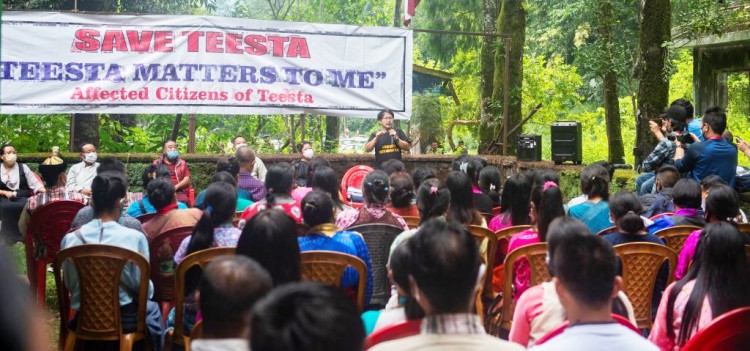




















Thursday, Oct 07, 2021 08:00 [IST]
Last Update: Thursday, Oct 07, 2021 02:21 [IST]
‘Declare last free flowing Teesta stretch in Dzongu as river sanctuary’
GANGTOK,: The Lepchas of Dzongu in North Sikkim on Tuesday reignited their protest against the proposed mega hydropower projects in Dzongu.
Hundreds gathered at Namprikdang, the confluence of rivers Teesta and Rongyong Chu in Dzongu, to demonstrate their strong opposition against the 520 Mw Teesta Stage-IV power project and 300 Mw Panan power project, both in Upper Dzongu.
Bongthings, the Lepcha priests, also performed rituals at the site seeking blessings to help them “save Teesta”.
Affected Citizens of Teesta (ACT), an apolitical body demanding scrapping of hydel projects in Sikkim, stated that with the setting up of the Teesta Stage-IV and Panan projects in Upper Dzongu, allotted to National Hydro Power Corporation (NHPC), they are concerned about protection of environment and socio-cultural ethos.
The ACT maintained that the mega hydropower projects at Dzongu would destroy the rich Himalayan ecosystem and the cultural heritage of the Lepcha community who worship nature.
“The State government had during the SDF rule declared Dzongu as indigenous Lepcha habitat and natural habitat for butterflies and wildlife. We are still unable to understand as to why the government, after declaring Dzongu has natural and indigenous habitat, is building tunnels. We demand answer from the government,” said ACT general secretary Gyatso Lepcha.
“Mega hydro projects in the ecologically sensitive Himalayan ecosystem are harmful. Several landslides, flash floods and earthquakes have taken place after the construction of dams on Teesta River in Dikchu and Chungthang,” said Gyatso.
The ACT general secretary also appealed the government to declare the last free flowing stretch of Teesta in Dzongu as a river sanctuary. He said, “Sikkim is known for its green environment, ecology and sustainable development and we suggest the State government to declare this stretch as a river sanctuary which will be a first-of-its-kind in the country.
“In countries like New Zealand, rivers have been granted the same legal rights as a person. Even if we cannot give the rivers a human status, why can’t we at least declare this stretch of river as a sanctuary?”
The ACT also reminded the government that the area falls within Kanchenjunga National Park, a UNESCO world heritage.
“State Forest minister Karma Loday Bhutia recently said that the biodiversity in North Sikkim was in danger because of defence projects and hydro projects. This is government openly accepting that the hydropower is affecting biodiversity. We welcome the Forest minister’s statement and at the same time we want to remind the government their statement will contradict if the Stage-IV is implemented.”
The locals blamed the State government of not being serious on the issue of dams in Dzongu and expressed dismay over the “dilly-dallying tactics” of the SKM government in resolving the issue.
“The ruling party made all the tall promises before 2019 elections and even came with a song ‘Teesta, Rangeet; nadi, khola’ and now they are blaming the previous government and doing nothing, which we don’t like,” said Sangdup Lepcha, a local farmer.
They also refuted dams as a “form of development from government”.
“There is a word being spread that the project will bring economic development but it’s been 13 years since the compensation for Panam project was provided and we haven’t seen a single family benefitting,” said Gyatso.
Sangdup added, “Instead, bring tourism infrastructure or programme under small scale industries. We don’t want development at the cost of nature, our identity and our cultural heritage.”
He also accused the government of hoodwinking them by building statue of Lepcha deity Mun Solong and commissioning tunnels underneath.
“It’s no more a Dzongu issue but a Sikkim issue. No means no, no more dam!”
Likewise, Gyatso lashed out at pro-dam lobby for allegedly spreading propaganda that compensation for Teesta Stage-IV will be distributed soon. “They are trying to entice our people who have already suffered. To the people on the left bank of the river who are talking about compensation, we want to tell them that the main project component of Stage-IV which is six and a half kilometre long dual tunnel will be in Dzongu, the power station will be in Dzongu and siltation tunnel will be in Dzongu area. Take all of the components to the left bank if you are interested, we have nothing to say.”
Gyatso mentioned that all affected Gram Panchayts have out rightly objected to the projects in a Forest Right Act Gram Sabha, which is mandatory to implement the project. “Eight gram panchayats have rejected, so it is clear that at least in Dzongu side the affected GPUs are against the project.”
“We also approached the Ministry of Environment in 2018 where we have submitted all these reports. Sikkim government still has not been able to reply to the ministry in this regard.”
“Government of Sikkim should stop doing these illegal practices.”
“Teesta is slowly disappearing through tunnels; it is a time to reflect. There are already 15-16 dams in Sikkim and we have not heard a single success story. Everyone affected by dams are suffering,” added Gyatso.
